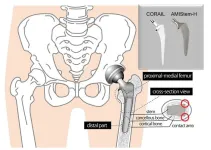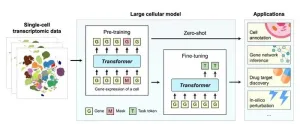(Press-News.org) CORVALLIS, Ore. – Lead levels in moss are as much as 600 times higher in older Portland, Oregon, neighborhoods where lead-sheathed telecommunications cables were once used compared to lead levels in nearby rural areas, a new study of urban moss has found.
The findings raise concerns about lead exposure in pre-1960 neighborhoods where the cables were common and in some cases are still in place even though they are no longer in use, said Alyssa Shiel, an environmental geochemist at Oregon State University, and the study’s lead author.
Lead is a highly toxic metal. Children are particularly vulnerable to lead exposure, which can lead to developmental delays, difficulty learning and behavioral issues.
“The results were pretty surprising. The vast majority of the samples with high lead levels were in areas with these old telecom cables,” said Shiel, an associate professor in OSU’s College of Earth, Ocean, and Atmospheric Sciences.
“Based on these findings, we’ve already started research to understand if and how the lead is getting into the environment. By doing that, we can learn if people are being exposed to the lead, and if so, by how much.”
The study was just published in Nature Communications Earth & Environment. Co-authors are Sarah Jovan of the U.S. Forest Service and Christina Murphy of Oregon State.
Shiel began studying lead in urban moss in Portland several years ago, following research by Jovan that identified high levels of cadmium in Portland ultimately traced to local glass manufacturing businesses that used cadmium-based pigments to make colored glass.
Moss growing on trees in urban areas is an effective air monitoring system because it has a wide surface area to collect contaminants that settle out of the air around it.
“These mosses are letting us know what is being picked up in the air we breathe,” said Shiel, who is also a member of the Pacific Northwest Center for Translational Environmental Health Research at OSU.
The researchers’ goal for the new study was to better understand urban lead levels and learn more about their potential sources. Samples of Orthotrichum lyelli, a type of moss typically found growing on trees, were collected from across Portland in 2013, and in nearby rural areas in 2017.
The findings showed nearly 12 times higher lead levels in urban Portland than found in rural areas nearby. Chemical analysis indicates that much of the lead in the environment is due to leaded gasoline, which continues to persist in the environment nearly three decades after it was banned in the United States.
“The lead introduced into the environment by leaded gas just hasn’t gone away. We have to live with it,” Shiel said.
But some older neighborhoods showed much higher concentrations of lead, which left the researchers puzzled and looking for more answers. An investigation published in 2023 by the Wall Street Journal connecting lead in older cities to telecommunications cables spurred a new line of inquiry for Shiel and her colleagues.
In summer 2023, the researchers collected additional moss samples, this time focusing on older neighborhoods where lead-sheathed telecommunication cables are still in place or had been removed in the recent past.
“We wanted to see if the impact of lead cables was consistent across neighborhoods where the cables were present,” Shiel said.
They found that neighborhoods with lead cables had more than two times the lead levels of those without lead cables, and more than 38 times higher than the samples from rural areas. The highest concentrations of lead were found in samples collected within one meter of a lead cable.
The researchers hypothesize that lead from the cables is being leached by rain slowly over time, accumulating in the soil and vegetation including moss below. Contaminated soil can also become airborne, transporting lead to areas not directly under the cables.
“We do see that the lead is migrating,” Shiel said. “The moss samples are showing that lead is not just dormant in soil near the telecom cables but is being mobilized in the air.”
More research is needed to understand how far lead from the cables may be spreading, Shiel noted, and the researchers plan to conduct soil testing in these areas next to determine how much lead is in the soil.
There is enough evidence of high levels to raise concerns about potential health impacts, she said.
“We were not expecting this result. But whether or not these higher levels of lead result in people being exposed depends in part on what people are doing in those places,” Shiel noted. “Right now, we are recommending people avoid interacting with or disturbing soil in those areas where these cables are or were present in the recent past.”
Shiel has developed a website with a map that shows the age of different neighborhoods across the city, as well as pictures of old telecom cables, so residents can determine if their neighborhood has these cables or my have had them in the past. The site, bit.ly/4cyuuSW, includes additional information about the potential lead contamination and how to reduce risk of exposure.
Shiel emphasized that other sources of lead should not be overlooked. The most common source of lead poisoning in the U.S. is household dust and soil containing lead from lead-based paints, she noted.
The federal Centers for Disease Control and Prevention recommend all children who are at risk for lead exposure be tested for lead poisoning.
“I would encourage parents to discuss lead testing with their child’s health provider,” Shiel said. “Seeking a test would be a reasonable course of action for concerned families.”
END
Study of urban moss raises concerns about lead levels in older Portland neighborhoods
2024-07-23
ELSE PRESS RELEASES FROM THIS DATE:
Preclinical model offers new insights into Parkinson’s disease process
2024-07-23
A new preclinical model offers a unique platform for studying the Parkinson’s disease process and suggests a relatively easy method for detecting the disease in people, according to a new study led by Weill Cornell Medicine researchers.
In the study, published July 23 in Nature Communications, the researchers showed that knocking out a key component involved in protein transportation in the light-sensing rod cells of mice leads to the retinal accumulation of the aggregates of a protein called alpha-synuclein found in patients with Parkinson’s disease.
“This is a really unique model involving a pathology that seems more like human Parkinson’s than what we see in ...
New rapid method for determining virus infectivity
2024-07-23
A new method that can rapidly determine whether a virus is infectious or non-infectious could revolutionise the response to future pandemics.
Called FAIRY (Fluorescence Assay for vIRal IntegritY), the assay can screen viruses against virucidal antivirals in minutes, allowing for the effectiveness of antiviral measures, such as disinfectants that break the chain of infection, to be quickly determined.
Dr Samuel Jones from Birmingham’s School of Chemistry led the research team that developed the FAIRY assay. ...
HIV vaccines tested in PrEPVacc fail to reduce infections
2024-07-23
The results of the PrEPVacc HIV vaccine trial conducted in Eastern and Southern Africa, which ran between 2020 and 2024, show conclusively that neither of the two experimental vaccine regimens tested reduced HIV infections among the study population.
Vaccinations in the PrEPVacc trial were stopped in November 2023 (and publicly announced in December 2023) when it became clear to independent experts monitoring the study data that there was little or no chance of the vaccines demonstrating efficacy in preventing HIV acquisition.
The PrEPVacc ...
Study by TU Graz shows that abrasion emissions from trains are not negligible
2024-07-23
In addition to exhaust emissions, abrasion emissions from tyres and brakes have become increasingly important when assessing the environmental impact of traffic. However, the focus here was on road vehicles; rail was hardly considered. In a study commissioned by the German Centre for Rail Transport Research (DZSF), researchers from the Institute of Thermodynamics and Sustainable Propulsion Systems at Graz University of Technology (TU Graz) have now been able to prove that so-called non-exhaust emissions from rail transport also have a relevant influence on air quality and soil pollution.
Half of the daily particulate matter limit due to trains ...
Heat-sensitive trees move uphill seeking climate change respite
2024-07-23
Trees in the Brazilian Atlantic Forest are migrating in search of more favourable temperatures with species in mountain forests moving uphill to escape rising heat caused by climate change, a new study reveals.
Most species in higher parts of the Brazilian Atlantic Forest are moving upwards as temperatures rise, but scientists say that those trees which thrive in colder temperatures are at risk of dying out as the world continues to warm.
Researchers studying the forest, which stretches along the Brazil’s Atlantic seaboard, have also discovered that some trees in ...
Arm robots are not the answer for stroke rehabilitation
2024-07-23
Commercial arm robots are increasingly deployed in order to aid stroke patients in their recovery. Around 80% of patients have problems with their arm function. Robots are also seen as a solution for financial, and staffing, shortcomings in the healthcare sector. However, research led by Amsterdam UMC now shows that they offer no clinically meaningful effects for patients. The research is published today in Neurology.
"In particular countries such as China, Japan and South Korea, but also in North America and Europe, are UL-Robots seen more ...
Staying hip to orthopedic advances: Comparing traditional and new hip replacement stems
2024-07-23
Osaka, Japan — Needing a hip replacement is unfortunate, but even more unfortunate is to need to do it again.
Surgeons at Osaka Metropolitan University have provided new insights into the performance of two types of stems used in total hip replacement surgery. Their findings are expected to contribute to the enhancement of long-term outcomes, improving patients’ quality of life and reducing the need for revision surgeries.
Their paper was published in The Bone & Joint Journal on June 1.
The hip joint, which connects the femur, or thighbone, to the pelvis, plays a crucial ...
Brain care score for dementia and stroke also predicts late-life depression
2024-07-23
Late-life depression, typically defined as depression with onset in individuals over 60 years of age, can affect up to a third or more of people older than 60 and can be debilitating. But, like other neurological conditions, an individual’s risk may be influenced by lifestyle choices. Researchers from Mass General Brigham previously developed and validated the Brain Care Score (BCS) for helping patients and clinicians identify lifestyle changes that may reduce their risk of dementia and stroke. Now, with collaborators at Yale University, they have shown that a higher BCS is also associated with a ...
A window of opportunity for climate change and biodiversity
2024-07-23
World leaders must take advantage of a pivotal window of opportunity for forging a much-needed joined-up approach to tackle climate change and biodiversity loss, say scientists from ZSL and York University. Without this, work on tackling either crisis could inadvertently harm progress on the other.
Published today (Tuesday 23 July) in the Journal of Applied Ecology, a paper from international conservation charity ZSL and researchers at York University, Toronto, titled ‘The Kunming-Montreal Global Biodiversity Framework and the Paris Agreement need a joint work programme for climate, nature, and people’ conceptualises how a joint work ...
Quantitative Biology journal features groundbreaking perspectives on large cellular models
2024-07-23
In a landmark move to advance the frontiers of artificial intelligence, the Quantitative Biology (QB) journal has published a comprehensive commentary titled "Current Opinions on Large Cellular Models," highlighting the cutting-edge developments in the field of large cellular models (LCMs). The journal has brought together a consortium of leading scholars from China, the United States, and Canada to delve into the future of AI-driven biological research.
The commentary features influential authors behind some of the most impactful LCMs, such as scBERT, Geneformer, scGPT, scFoundation, and GeneCompass. These AI ...





